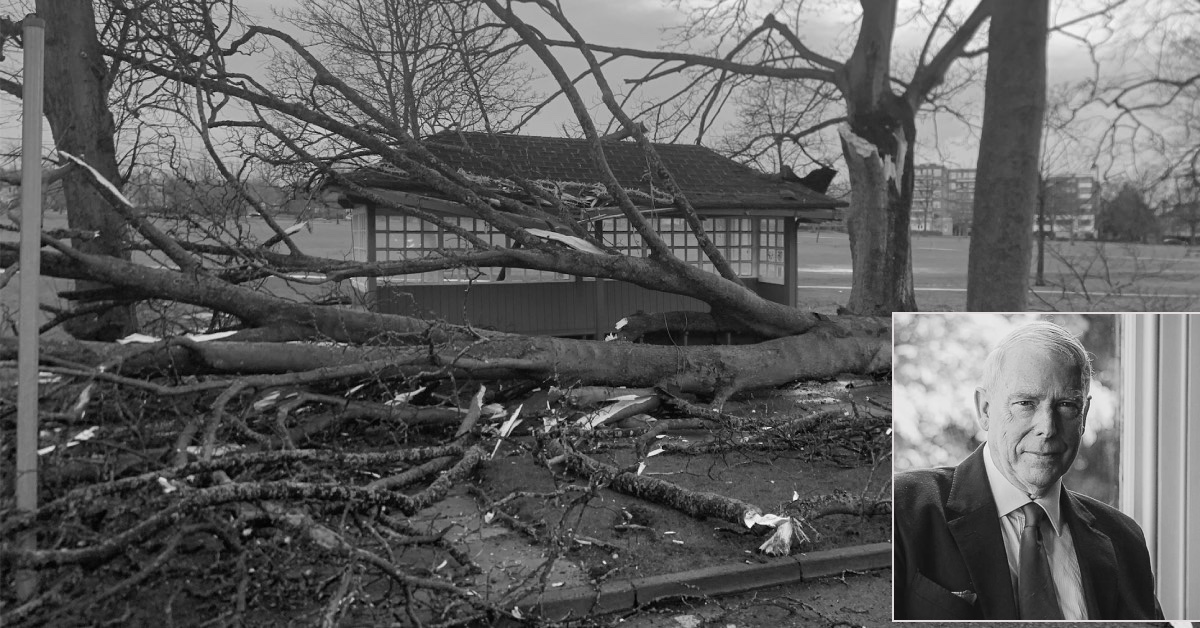Recent stormy weather has prompted celebrated Harrogate Historian Malcolm Neesam to look through his records at some of the great storms of the past, several of which were described by historian William Grainge:
The winter of 1799 was one of the worst ever recorded in northern Europe. One local victim was a Mr Swires, who, on February 8, set out on horseback to ride to Skipton. A terrific snow storm set in towards evening, and after stopping to dine at an inn on Hopper Lane, he resumed his journey, despite the entreaties of the landlord. Alas, he never reached his destination, but three weeks later, as the snow melted, he was found standing upright with his arm around a gatepost, evidently trying to reach Redshaw Hall.
There was very odd weather in 1826, when Yorkshire experienced the severest frosts and biggest snow drifts remembered by any one alive. In the summer the heat was equally uncommon and intense, and thunder storms were of great fury and of frequent occurrence. Several agricultural workers were killed by enormous hailstones, and on June 28, the thermometer was at 85° on Saturday and Sunday in the shade, and in the sun at 124°. Such was the drought and sultriness of the weather, that even in the midst of the hay harvest, prayers were offered up in the churches and other places of worship for rain. The following month saw devastating fires on the moors, with Ilkley Moor losing 500 acres.
In 1839, the most terrific storm of wind known in England during the nineteenth century passed across the country on January 7. Liverpool was the heaviest sufferer where no less than 116 lives were lost; and many ships were wrecked, swamped or cast ashore, and many buildings reduced to ruins. Leeds also suffered very heavily, especially its churches, and manufactories; the towers and spires of the former and the tall chimneys of the latter falling before the blast. In short no town, no village, and scarcely a single homestead which stood in its track, escaped without some marks of its fury. Haystacks and cornstacks were overturned, torn to pieces and scattered at random all over the country. Trees which had stood the storms of centuries crashed to the ground, and the trees in artificial plantations on high ground were literally prostrated by thousands.
Harrogate, considering its exposed situation, did not suffer as much as might have been expected; a few of its finest trees were blown down, chimneys toppled over; and slates from the roofs of houses scattered in great profusion. No lives were lost, but one escape was little less than miraculous – a large stone chimney on the west side of the Swan Hotel was blown down, crashed through the roof making a hole nine feet square; two of the daughters of Mr Jonathan Shutt, the proprietor were sleeping in a bed directly beneath it, one side of the bedstead was completely broken down and the whole of it, and its occupants covered with the rubbish; but the broken spars and timber had fallen in such a manner that the young ladies were protected from the direct impact of the falling mass, escaped comparatively unhurt, one of them only receiving a slight scratch on the cheek. Some large elms which grew in a field south of the Dragon Hotel were blown down, and out of the trunk of one of them were formed the first seats for the use of visitors that were placed on Harrogate Stray.
A severe storm shook the locality on the afternoon of June 3 1858, when the Bramhope Tunnel on the North Eastern Railway gave way at the Leeds end, and the water rushed through in a perfect torrent, and with tremendous noise. A train proceeding through the tunnel at about six o’clock in the evening was met by the current, and forced to put back; this was effected very slowly, the train being in the tunnel more than an hour. On its re-arrival at the north end, the accumulation of rubbish had been made so great, that the passengers had to leave the carriages, and walk back to Arthington. They were subsequently sent round by York, and reached Leeds about midnight.
The author recalls the great gale of 1962, when on Monday 12 February, hundred mile an hour winds lashed Nidderdale, causing a fearful amount of damage. In Harrogate, there were town-wide powercuts, disruption to the railways, and the loss of no less than 800 trees, four lamp columns, and massive destruction at the Harlow Hill nurseries. Many roofs were torn away, and dozens of town centre shops lost their windows. At Knaresborough, the war memorial was partly blown down, and the Town Hall bell tower came crashing through the roof.
Read More:
- Malcolm Neesam History: the colourful past of what could become Harrogate’s first mosque
- When legendary wrestlers Big Daddy and Giant Haystacks came to Harrogate
- Roller skating, Woolies and Carrington’s: Memories of the Harrogate diaspora
Did you know?
The Stray Ferret and the Harrogate Business Improvement District (BID) have worked with Malcolm Neesam to produce two fantastic history audio tours of Harrogate. Both last about an hour and are easy to do. The first will take you back to the golden age of Harrogate’s Victorian Spa days, the second will take you through the heart of the shopping district, stopping to learn about historic buildings as you go. To take a look click here.




